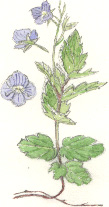 |
Germander SpeedwellMonday, 3rd June 2002, West Yorkshire |
![]()
![]()
![]()
![]() Rocks |
History |
Workshop |
Links |
Home Page
Rocks |
History |
Workshop |
Links |
Home Page
![]()
 There are some botanical details that escape me even when I wear my reading glasses to draw a plant. This is where a hand lens or a pocket microscope comes in handy.
There are some botanical details that escape me even when I wear my reading glasses to draw a plant. This is where a hand lens or a pocket microscope comes in handy.The plant's scientific name is Veronica chamaedrys; Veronica after the saint of that name, chamaedrys from the Greek for dwarf oak. Perhaps this refers to the lobed leaves.
It grows in grassy places, including our front lawn. I wouldn't normally pick wild flowers but the lawn is now due for mowing. Far from feeling that it's about time I applied weed killer I love to see the blue flowers of speedwell dotted amongst the daisies and buttercups.
![]()
Richard Bell,
wildlife illustrator
E-mail; 'richard@willowisland.co.uk'
![]() Next page |
Previous page |
This day in 2000 |
This month |
Nature Diary |
Home Page
Next page |
Previous page |
This day in 2000 |
This month |
Nature Diary |
Home Page
![]()